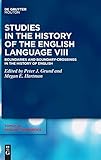Studies in the History of the English Language VIII : Boundaries and Boundary-Crossings in the History of English / ed. by Peter Grund, Megan Hartman.
Material type: TextSeries: Topics in English Linguistics [TiEL] ; 108Publisher: Berlin ; Boston : De Gruyter Mouton, [2020]Copyright date: ©2021Description: 1 online resource (X, 284 p.)Content type:
TextSeries: Topics in English Linguistics [TiEL] ; 108Publisher: Berlin ; Boston : De Gruyter Mouton, [2020]Copyright date: ©2021Description: 1 online resource (X, 284 p.)Content type: - 9783110627251
- 9783110639858
- 9783110643282
- 420.9 23
- PE1075 .S885 2021
- online - DeGruyter
- Issued also in print.
| Item type | Current library | Call number | URL | Status | Notes | Barcode | |
|---|---|---|---|---|---|---|---|
 eBook
eBook
|
Biblioteca "Angelicum" Pont. Univ. S.Tommaso d'Aquino Nuvola online | online - DeGruyter (Browse shelf(Opens below)) | Online access | Not for loan (Accesso limitato) | Accesso per gli utenti autorizzati / Access for authorized users | (dgr)9783110643282 |
Frontmatter -- Acknowledgments -- Contents -- Contributor addresses -- Introduction: Boundaries and boundarycrossings in the history of English -- Section 1: Conceptual and methodological boundaries -- 1. Scale and mode in histories of English -- 2. The blurred boundaries of genres-in-use: Principles and implications from rhetorical genre studies for English historical linguistics -- 3. Meanderings from early English to World Englishes: A Complex Systems perspective on morphosyntactic changes in wh-pronouns -- Section 2: Linguistic boundaries -- 4. First or best, last not least: Domain edges in the history of English -- 5. Expanding boundaries of a function word: Uses of one in Early Modern and Modern English -- 6. Non-correlative commas between subjects and verbs in Early and Late Modern English sermons and scientific texts -- 7. Old English verbs of envy: Class membership and grammatical behaviour -- Section 3: Language and language variety boundaries -- 8. Germanic /r/ as an isogloss, rhotacism, and the West Germanic gemination -- 9. Migration, localities, and discourse: Shifting linguistic boundaries in Swedish-American cookbooks -- 10. Specimen texts and boundaries in the history of the English language -- Coda: HEL-bound -- Index
restricted access online access with authorization star
http://purl.org/coar/access_right/c_16ec
This volume collects essays that approach notions of creating, maintaining, and crossing boundaries in the history of the English language. The concept of boundaries is variously defined within linguistics depending on the theoretical framework, from formal and theoretical perspectives to specific fields and more empirical, physical, and perceptual angles. The contributions to this volume do not take one particular theoretical or methodological approach but, instead, explore how examining various types of boundaries—linguistic, conceptual, analytical, generic, physical—helps us illuminate and account for historical use, variation, and change in English. In their exploration of various topics in the history of English, contributions ask a range of questions: what does it mean to set up boundaries between time periods? When do language varieties have distinct boundaries and when do they overlap? Where do language users draw up clausal, constructional, semantic, phonetic/phonological boundaries? Thus, the chapters explore not only how boundaries illustrate synchronic and diachronic features in the history of the English language but also what we can discover by questioning perceived or actual boundaries.
Issued also in print.
Mode of access: Internet via World Wide Web.
In English.
Description based on online resource; title from PDF title page (publisher's Web site, viewed 25. Jun 2024)


